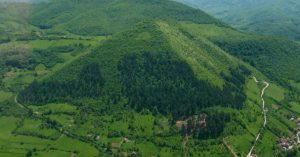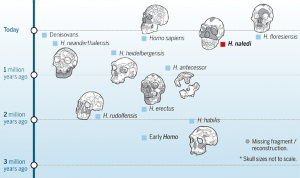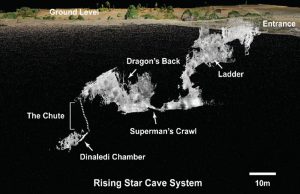In 2005, Semir Osmanagich was convinced that he had made one of the biggest finds in archaeological history. He claimed that some of the hills nearby the city of Visoko in Bosnia and Herzegovina were actually pyramids built by an unidentified ancient society (figure 1). If this was true, they would be the tallest step pyramids in the world, with the largest, dubbed the Pyramid of the Sun by Osmanagich, measuring 720 feet tall, which is about 240 feet taller than the Pyramid of Khufu, the largest pyramid in Egypt. He also believed them to be the oldest pyramids in the world, that they were built 12,000 years ago, meaning that they preceded the construction of the oldest Egyptian pyramid by over 8,000 years (Woodard 2009).

Figure 1: A pyramidal hill located right outside the town of Visoko, thought of by many in Bosnia to be an ancient pyramid covered in earth and vegetation.
Other than the shape of the hills resembling that of pyramids, Osmanagich had no clear archaeological evidence to back up his claim. The European Association of Archaeologists even called the pyramids “A cruel hoax on an unsuspecting public” and labeled his theory unscientific and all his findings either natural features or artifacts that came from the groups of people that have lived in the valley since the Greco-Roman period (Keats 2018). Osmanagich further discredited his own case by making farfetched speculations about the pyramids, like how they were made out of a concrete that is better than what is used today and how they allowed people to communicate via torsion fields while also improving their health and lengthening their lifespans (Keats 2018).
Despite everything that was working against Omanagich’s conjectures, they were eagerly embraced by much of Bosnia, including many government officials, resulting in support of the theory being tied into Bosnian nationalism, with any skepticism branded as anti-Bosnian (Woodard 2009). This is not surprising, seeing as accepting this glamorous addition to the country’s history could be a convenient distraction from the relatively recent genocide that Bosnia is still recovering from; it was something people could be proud of.
In addition to raising the country’s spirits, the pyramid theory also boosted the area’s economy. Tourists, including many from outside Bosnia, began flocking to the pyramidal hills, buying souvenirs (figure 2), taking tours of the area and even taking part in the excavations (Crosby 2017). The problem with all of this, other than feeding people claims not backed by science as the truth and benefiting monetarily from it, is that artifacts are being found by Osmanagich and his volunteer diggers. These artifacts, left behind by the various peoples that are known to have occupied the area, are having their contexts destroyed. Because of the untrained workforce and lack of documentation, Osmanagich’s attempts to prove his vision of the area’s history is erasing whatever the actual history is.
Additional Readings
https://www.robertschoch.com/bosnia.html
https://www.gaia.com/article/mystery-of-torsion-fields
Works Cited
Crosby, Alan
2017 Whether Real or a Hoax, Bosnian ‘Pyramids’ Bringing Concrete Benefits to Town. Radio Free Europe / Radio Liberty. https://www.rferl.org/a/bosnia-visoko-pyramids-osmanagic-economy-hoax/28725843.html, accessed December 1, 2018.
Keats, Jonathon
2018 Revisiting the Bosnian Pyramid Scheme. Discover. http://discovermagazine.com/2018/sep/pyramid-dreams, accessed December 1, 2018.
Woodard, Colin
2009 The Mystery of Bosnia’s Ancient Pyramids. Smithsonian. https://www.smithsonianmag.com/history/the-mystery-of-bosnias-ancient-pyramids-148990462/, accessed December 1, 2018.
Pictures
Figure 1 http://www.historydisclosure.com/ancient-bosnian-pyramids-discovery-dont-want-know/
Figure 2 https://www.rferl.org/a/bosnia-visoko-pyramids-osmanagic-economy-hoax/28725843.html



